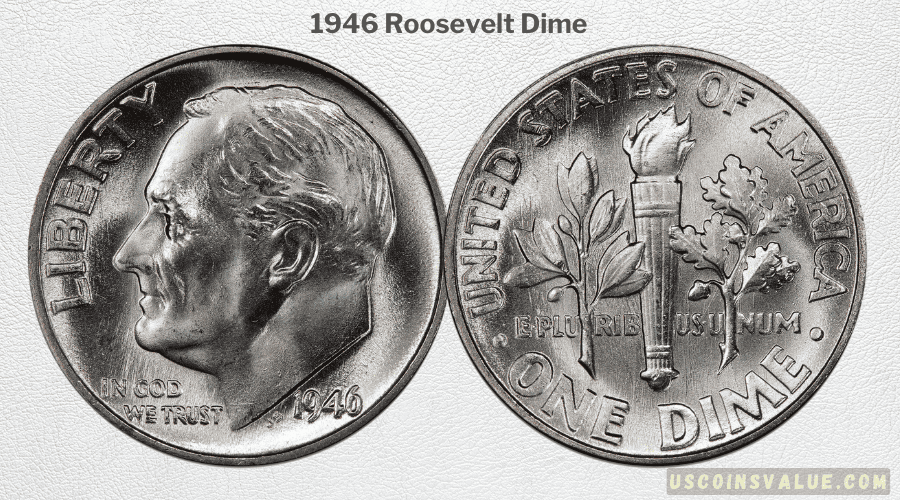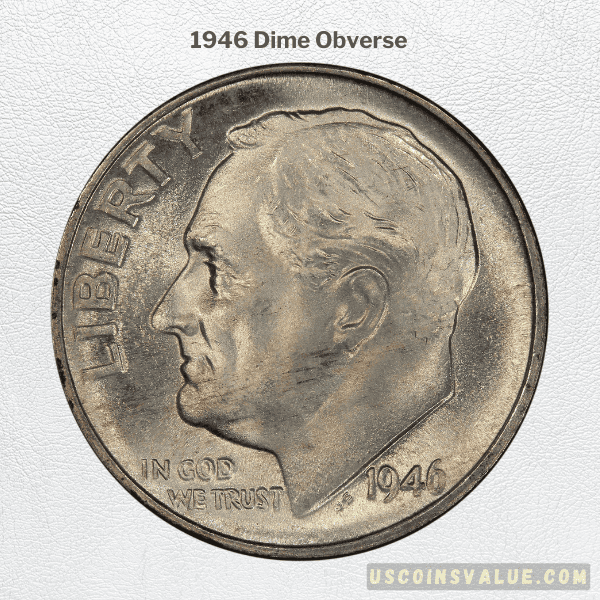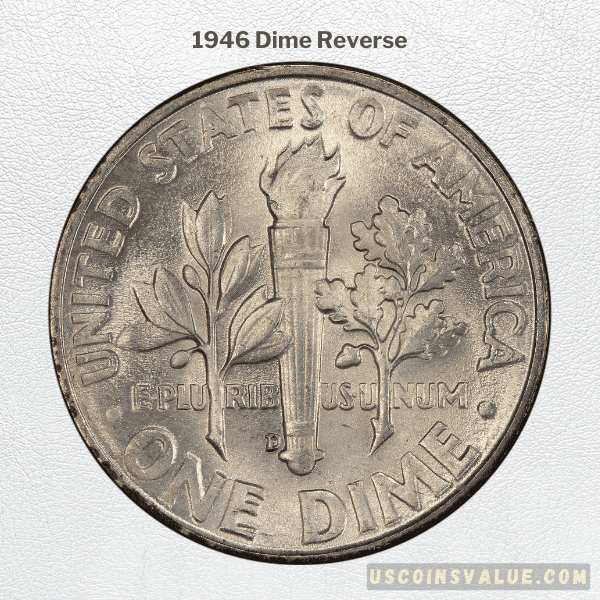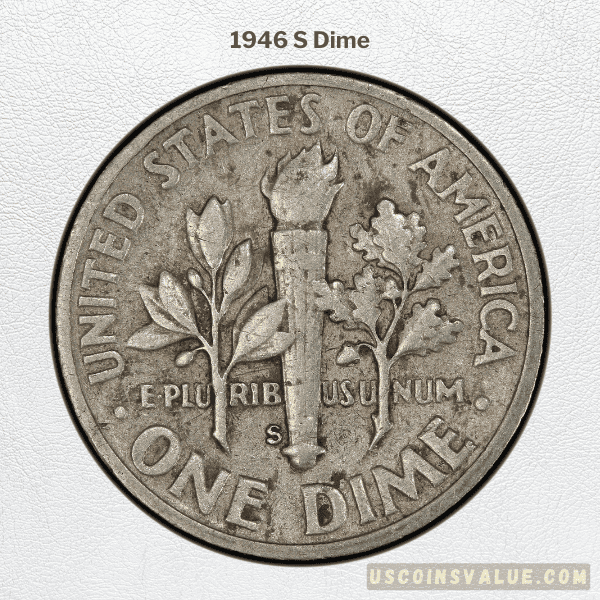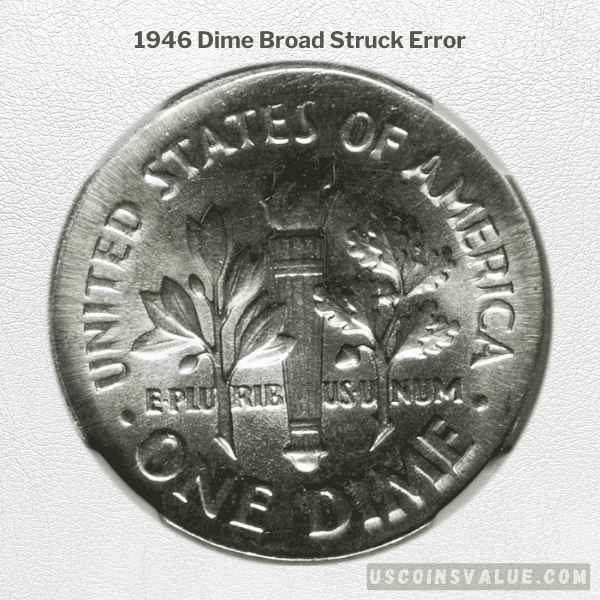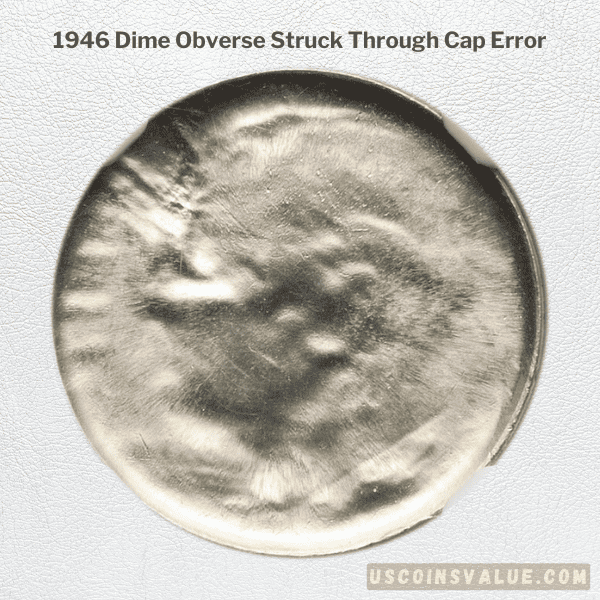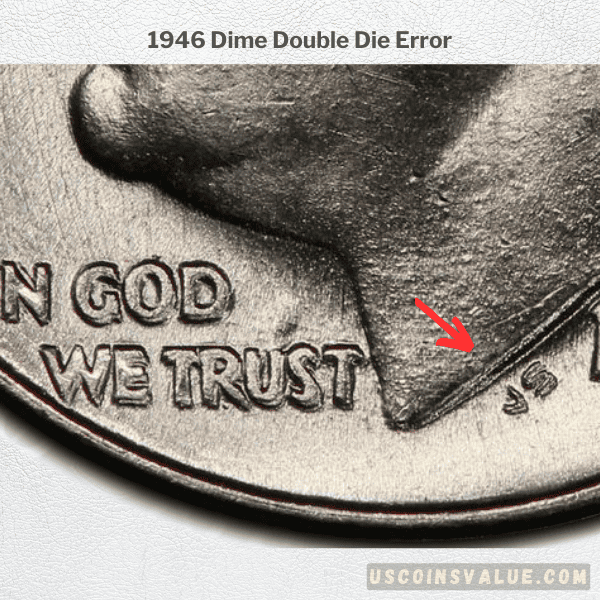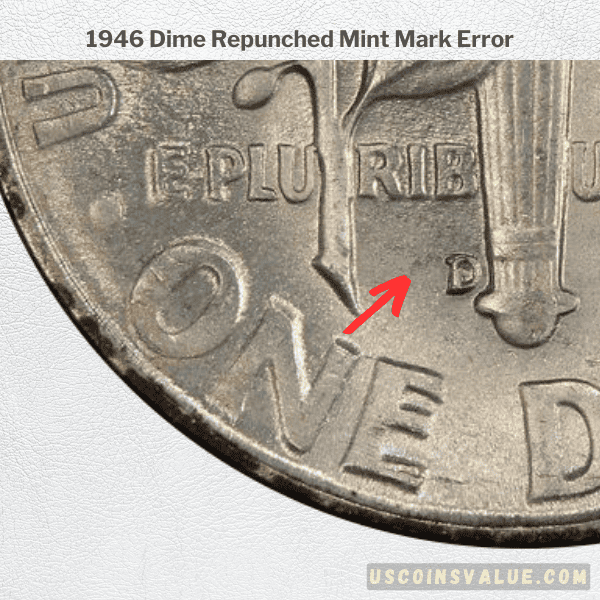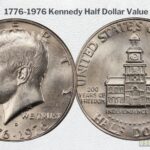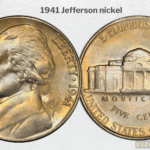The 1946 dimes–popularly known as the 1946 Roosevelt Dimes–are no ordinary currency. As the name suggests, they pay homage to the 32nd president of America, Franklin D. Roosevelt.
Despite their significance, they rarely cost more than their weight in silver of $1.70. But chances are, you have seen certain coins selling for as much as $1300. Case in point, a 1946-D regular strike dime graded at MS 69 sold for $12,650 in 2004.
So, what causes this difference in their value?
This guide aims to answer this question and others that might have crossed your mind by exploring the history, varieties, and unique errors of the 1946 dime.
The Birth of the 1946 Roosevelt Dime
The Mercury Dime or Winged Liberty Dime had a good run for about 29 years. But in 1945, it officially retired, paving the way for the 1946 Roosevelt Dime.
But what happened in 1945 that caused this shift?
It’s simple, President Franklin Delano Roosevelt died after years of dealing with poliomyelitis (polio).
Roosevelt was America’s most popular president, majorly because he led his people through the harrowing depths of the great depression and played a significant role in ending the horrendous World War II. So, his death in 1945 left a deep hole in the hearts of most Americans.
Fortunately, U.S. leaders came up with an ingenious way to honor the fallen hero–immortalizing him on the obverse of the dime.
But there is another reason why the Roosevelt dime replaced the Mercury dime. That being, it paid tribute to Roosevelt’s effort in establishing the National Foundation for Paralysis, an organization that raised money for Polio research and helped individuals who fell victim to the disease. Later on, the organization was renamed to March of Dimes.
Interestingly, the Roosevelt dime was the first regular issue American currency designed by a Mint engraver in over 40 years. Due to limited time, the U.S. Mint asked John R. Sinnock to design the new dime, as he had created Roosevelt’s presidential medal. He is also the guy who came up with the design for the Franklin Hall Dollar.
After designing the coin, Sinnock included his initials “JS” on the obverse, creating a controversy. Strong anti-communist groups at the time mistakenly associated the designer’s initials on the coin with the communist leader of Russia, Joseph Stalin. Fortunately, the Mint quickly saved its neck by explaining the origin of the initials.
In 1946, the dimes featured a composition of 90% silver and 10% copper, as this was the standard for U.S. coins. However, rising silver prices forced the mint to change the dime composition in 1965 to copper-nickel alloy (75% copper and 25% nickel). Roosevelt dimes have maintained this composition to date.
1946 Appearance and Features
1946 Roosevelt Dime Specifications
- Type: Roosevelt Dime
- Year: 1946
- Mint Location: Denver, San Francisco, and Philadelphia
- Designer: John R. Sinnock
- Mintage: 344,585,000
- Face Value: $0.10
- Composition: 90% silver, 10% copper
- Silver Weight: 0.07234 oz
- Total Weight:5 grams
- Edge: Reeded
- Diameter: 9mm
- Melt Value: $1.71 (As of 9/23/2023)
Obverse and Reverse Design
As said earlier, a portrait of Franklin Roosevelt facing left decorates the obverse of the 1949 dime. The coin also includes other design features like:
- IN GOD WE TRUST–to the right of the image.
- LIBERTY–above the president’s portrait.
- “JS”–Chief engraver John R. Sinnock’s initials pop up at the truncation of the neck.
- 1946–the date below Roosevelt’s chin represents the year of issue.
On the reverse, the Lady’s Liberty torch dominates the center of the coin, representing liberty and freedom. It’s accompanied by an olive branch to signify peace and an oak branch to symbolize strength and independence.
Initially, Sinnock design for the dime featured a lit torch and branches held by a hand, but the design committee rejected it.
In addition, the reverse of the coin includes the following inscriptions:
- E PLURIBUS UNUM
- UNITED STATES OF AMERICA
- ONE DIME
- D or S MINT MARK
1946 Roosevelt Dime Varieties
In 1946, the U.S. Mint introduced three varieties of the Roosevelt dimes minted in 3 centers, namely Denver, Philadelphia, and San Francisco.
The Philadelphia Mint recorded the highest mintage of over 255 million dimes without a mint mark. Although the Denver and San Fransisco mint had huge mintage, it was considerably lower than the main minting facility.
The table below shows a summary of the estimated mintage from each center:
| Minting Facility | Mintage | Mint Mark |
| Philadelphia | 255,250,000 | N/A |
| Denver | 61,043,500 | D |
| San Francisco | 27,900,00 | S |
In total, the production exceeded 344 million, marking the highest mintage of dimes ever struck until 1962.
All the centers minted regular strike coins, so don’t expect to find Proof varieties for the 1946 dime series.
What Makes the 1946 Dime Valuable?
You would think the 1946 dimes’ unique history would make them super rare, but that’s not the case.
These coins were struck in huge numbers to replace the retiring mercury dimes. As a result, they are readily available in grades ranging from Good through Mint state.
Most coin dealers have a significant supply of 1946 dimes on hand, meaning you have plenty of opportunity to find a coin that suits your budget.
Nevertheless, there are a few conditional rarities that can fetch high prices in the open market. This mostly includes coins that show a high degree of preservation or at graded at a high mint state. Take, for instance, this 1946-D dime (Regular Strike) with a PCGS grade of M68, which sold for around $1,000 on eBay in 2018.
But this is just one example. There are many more samples that command an even higher premium. In 2007, a 1946-S with the same grade brought in $1,850 at Heritage Auctions.
Full Bands 1946 Dimes
If you think conditional rarities are impressive, wait until you hear about the 1946 Dimes with Full Bands.
What are full bands you might wonder?
They refer to the horizontal twin bands present on the Lady Liberty torch that decorate the reverse of the Roosevelt dimes.
Roosevelt dimes that qualify for the PCGS full band designation often exhibit a strong detail, with the upper and lower horizontal bands of the torch being fully separated. If there are cuts or marks on the horizontal bands, the coins are said to have partial bands.
For 1946 dimes, only a few specimens have this designation, and most fall at grade MS 66 and above.
This table provides you with a list of the most expensive 1946 dimes with full band designation according to PCGS:
| Full Bands Variety | Grade | Price | Auction/Market |
| 1946 10C, FB (Regular Strike) | MS68 | $10,869 | Heritage Auctions |
| 1946 -S 10C, FB (Regular Strike) | MS68 | $5,819 | Bowers & Merena |
| 1946 -D 10C, FB | MS68 | $4,888 | Heritage Auctions |
How Much Is A 1946 Dime Worth?
After its release in 1946, most collectors and members of the public hoarded the Roosevelt dimes. Some with the hope that their value will increase exponentially over time and others wanting to just have a piece of American history.
No matter their reasons, the hoarding had a significant impact on the value of the 1946 dimes, as there was an abundant supply of mint state specimens.
In circulated condition, 1946 Roosevelt dimes cost around $1 to $4. Sure, this might not seem so much, but compared to its face value of $0.10, a $2 or $3 asking price is a serious jump.
That said, recent increases in silver prices have seen silver coins, including the 1946 dimes, gaining some attention. Let’s now break down the value of each 1946 dime variety.
1. 1946 “no mint mark” Dimes Value
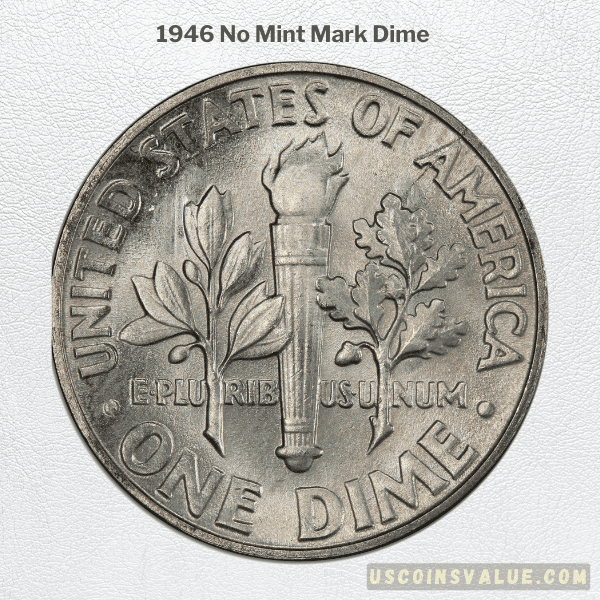
Here’s a summary of the 1946 “no mint mark” dimes based on their prices under different conditions:
| 1946 “no mint mark” Value Chart | |
| Grade | Price |
| MS 64 | $10.00 |
| MS 65 | $28.00 |
| MS 66 | $236.00 |
| MS 67 | $763.75 |
| MS 68 | $12,650 |
2. 1946-D Dimes
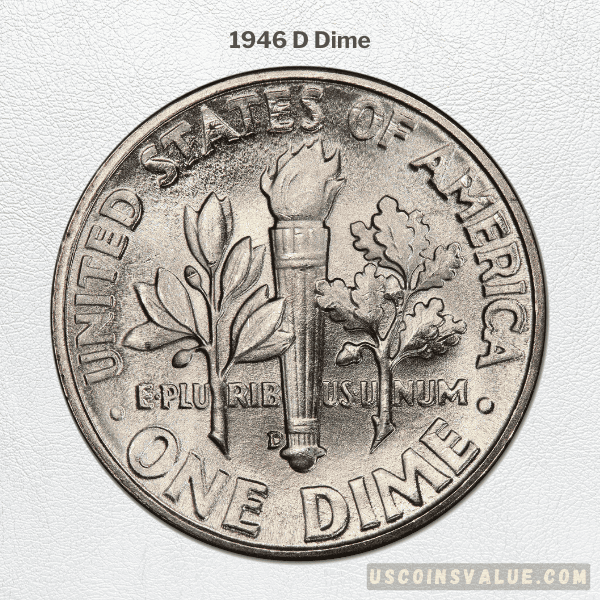
Something else, many Roosevelt dimes from Denver Mint displayed full bands (or full torch) than from the other two facilities. But if you want to get yourself a valuable piece, find coins with strong detail work, not just full bands.
In the open market, 1946-D Roosevelt dimes, in mint state conditions, sell for the following prices:
| 1946-D Value Chart | |
| Grade | Price |
| MS 64 | N/A |
| MS 65 | $25.00 |
| MS 66 | $89.00 |
| MS 67 | $300.00 |
| MS 68 | N/A |
Note – N/A means there is not enough price data for the 1946-D dimes with the specific grade.
3. 1946-S Dimes Value
The San Fransisco mint had the lowest mint of Roosevelt dimes in 1946, but the coins are not rare, especially in circulated condition. However, if you move past MS63, they become somehow scared, and their value increases from $2 to $40.
From MS 65 to MS 67, 1946-S dimes become limited, with only a couple of examples recorded by PCGS and NGC. Check out the potential price of these coins in various grade levels below:
| 1946 – S Value Chart | |
| Grade | Price |
| MS 64 | $34.59 |
| MS 65 | $74.00 |
| MS 66 | $212.00 |
| MS 67 | $334.00 |
| MS 68 | $3,525.00 |
1946 Dime Error List
Minting errors are not something new in 1946 Roosevelt dimes. Due to the high mintage, most coins exhibit one or two forms of errors caused by worn-out or damaged dies.
Collectors love these error coins because of their high value in the marketplace. But keep in mind, that not every dime with an error will demand a premium.
The most desired examples by numismatists include 1946 dimes with double die obverse (or reverse) and re-punched mint marks. These specimens are not only interesting but valuable.
Below we’ve discussed a few 1946 dimes errors that you should look out for.
1. Broad struck Error
If you’re looking to add a unique piece to your coin collection, look for 1946 Roosevelt dimes with Broad struck error.
This error happens when a coin is struck without a retaining collar, which firmly holds down the coin during striking. The collar helps to create the edge of the coin. So, if it’s missing, the planchet will expand outward in all directions.
In simple terms, the design elements of the obverse and reverse, like images, will stretch or expand, becoming wider and thinner. At the end, the coin will appear misshapen.
Dimes with broad struck errors are of interest to collectors and often collect a higher price than regular strike pieces.
Here are a few examples of 1946 Roosevelt coins with broad struck errors and the prices they sold for:
- 1946 10 C Roosevelt Dime–Broad struck graded at MS 66 and with Full Torch – sold for $258.50 in 2012
- An uncirculated 1946- S 10C Roosevelt Dime – Broad struck with 20% straight clip – sold for $109.00 in 2023
2. Obverse Struck Through Cap Error
Another fascinating error that caught our attention is the 1946 Roosevelt dime with an obverse strike through the cap error. This specimen rocking an exceptional MS 67 grade with full bands brought in $84 in early 2021.
But what causes this error?
Sometimes, a coin can be struck by an obverse die that has a coin stuck on it. When this happens, the stuck coin acts as the new die face that leaves its impression on the planchet. With each strike, the coin expands and thins out until it creates a cup-shaped appearance.
Usually, the coins struck with the die cap will have a strong ghost or mirror image on the obverse.
3. Double Die Errors
Our list of 1946 dime errors will not be complete without highlighting a few double-die errors.
For a better explanation, let’s check out this 1946 Roosevelt Dime with double-die obverse (DDO) and double-die reverse error (DDR). A collector paid around $750.00 for this piece on eBay in 2021.
This error coin stands out because it displays doubling on both obverse–more specifically on “JS” initials and the words “IN GOD WE TRUST”.
On the reverse, you can observe an element of doubling on the inscriptions “AMERICA”, “UNUM”, and “DIME”.
4. Re-punched-mint Mark Error
Last but not least, we have the 1946-D Roosevelt dime with a re-punched mint mark which sold for $110 at Great Collections.
As the name suggests, coins with this error have mint marks with double impressions or appear punched twice. This happens when the letter punch does not align properly with the coin during the minting process due to human errors or mechanical issues.
Closing Thoughts
As we wind up, it’s crucial to understand that the 1946 Roosevelt dimes are not rare due to their high mintage. But this is good news for people who want to put together an entire collection of U.S. coinage without spending a lot of money.
However, it doesn’t mean that there are no 1946 dimes that demand a premium. As seen above, dimes with unique errors can fetch anywhere from $80 to $750. And if you add an element of pristine or mint condition (excellent luster, strong design details, and full bands), well, the coins can sell for even a higher value–up to $1300 or more.
Overall, 1946 dimes are great for novice numismatics who wish to get their foot in the door.

